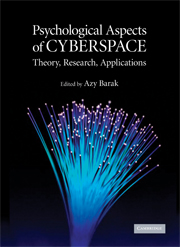Book contents
- Frontmatter
- Contents
- List of Tables
- List of Figures
- Preface
- List of Contributors
- 1 Reflections on the Psychology and Social Science of Cyberspace
- 2 Privacy, Trust, and Disclosure Online
- 3 Internet Abuse: Emerging Trends and Lingering Questions
- 4 Flow Experience in Cyberspace: Current Studies and Perspectives
- 5 Cybertherapeutic Theory and Techniques
- 6 Exposure in Cyberspace as Means of Enhancing Psychological Assessment
- 7 Down the Rabbit Hole: The Role of Place in the Initiation and Development of Online Relationships
- 8 The Sexy Side of the Internet: An Examination of Sexual Activities and Materials in Cyberspace
- 9 The Contact Hypothesis Reconsidered: Interacting via Internet: Theoretical and Practical Aspects
- 10 Influences on the Nature and Functioning of Online Groups
- 11 Online Motivational Factors: Incentives for Participation and Contribution in Wikipedia
- 12 How Internet-Mediated Research Changes Science
- Index
- References
4 - Flow Experience in Cyberspace: Current Studies and Perspectives
Published online by Cambridge University Press: 05 June 2012
- Frontmatter
- Contents
- List of Tables
- List of Figures
- Preface
- List of Contributors
- 1 Reflections on the Psychology and Social Science of Cyberspace
- 2 Privacy, Trust, and Disclosure Online
- 3 Internet Abuse: Emerging Trends and Lingering Questions
- 4 Flow Experience in Cyberspace: Current Studies and Perspectives
- 5 Cybertherapeutic Theory and Techniques
- 6 Exposure in Cyberspace as Means of Enhancing Psychological Assessment
- 7 Down the Rabbit Hole: The Role of Place in the Initiation and Development of Online Relationships
- 8 The Sexy Side of the Internet: An Examination of Sexual Activities and Materials in Cyberspace
- 9 The Contact Hypothesis Reconsidered: Interacting via Internet: Theoretical and Practical Aspects
- 10 Influences on the Nature and Functioning of Online Groups
- 11 Online Motivational Factors: Incentives for Participation and Contribution in Wikipedia
- 12 How Internet-Mediated Research Changes Science
- Index
- References
Summary
Cyberspace constitutes a specific environment; the investigations in this field are based either on the original cyberspace-dependent methods and theories, or on universal theories and methods worked out in diverse areas of knowledge, not necessarily closely connected with cyberspace. A psychological theoretical construct (with vast practical perspectives) introduced by Csikszentmihalyi, (2000/1975) known as optimal, or flow experience, alongside the methods of its measurement, basically refer to the universal, that is, nonspecific theoretical and methodological background. This traditional methodology was adapted and accepted within cyberspace; it represents a growing area of the investigators' activity in the field.
Like many other investigations of human behavior in cyberspace, flow-related studies are of both practical and theoretical significance. The practical significance is associated with the challenges deriving from business: a large body of research is stimulated by business expectations of acquiring advantages in the quality of offers to be suggested to customers. The theoretical significance stems from a supposition that optimal experience is an important construct mediating human activity in cyberspace, and thus represents a special level of psychological mediation of mental processes. The mechanisms of multiple mediation and remediation of a previously mediated experience are known to affect human psychic development (Cole, 1996; Vygotsky, 1962).
In this chapter, major research directions are presented and discussed, referring to the optimal, or flow, experience studies conducted within cyberspace environments.
- Type
- Chapter
- Information
- Psychological Aspects of CyberspaceTheory, Research, Applications, pp. 70 - 101Publisher: Cambridge University PressPrint publication year: 2008
References
- 14
- Cited by



